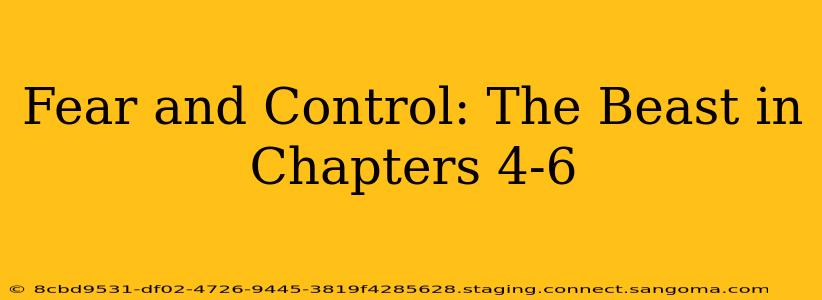Chapters 4-6 of [Insert Book Title Here] delve deeply into the complex interplay of fear and control, revealing the "beast" within the characters and the narrative itself. This analysis will explore how these themes manifest, their impact on the plot, and the author's masterful use of literary techniques to create a compelling and unsettling reading experience. We'll also address some frequently asked questions about these crucial chapters.
What is the significance of the setting in Chapters 4-6?
The setting in Chapters 4-6 plays a crucial role in amplifying the themes of fear and control. [Describe the setting specifically, referencing details from the book. For example: "The claustrophobic atmosphere of the abandoned mansion, with its creaking floorboards and shadowed corners, mirrors the characters' internal struggles and the ever-present sense of impending doom."] The author skillfully uses the environment to create a sense of unease and vulnerability, foreshadowing the conflicts to come.
How does fear manifest in the characters' actions?
Fear manifests in the characters' actions in a variety of ways, ranging from overt acts of aggression and self-preservation to subtle displays of anxiety and paralysis. [Provide specific examples from the book, demonstrating how fear shapes the characters' choices and interactions. For instance: "Character A's impulsive decision to flee reflects a deep-seated fear of the unknown, while Character B's rigid adherence to routine reveals an attempt to control their environment and mitigate their anxieties."] The author masterfully depicts the spectrum of human responses to fear, highlighting its multifaceted nature and its capacity to shape human behavior.
How is control used as a tool in Chapters 4-6?
Control, or the lack thereof, is a central theme woven throughout these chapters. Characters attempt to exert control over their circumstances, often in desperate and ultimately futile attempts to manage their fear. [Give concrete examples of how characters attempt to control others or situations, and how these attempts ultimately fail or backfire. For instance: "Character C's attempts to manipulate Character D demonstrate a need to exert power and control over a situation they perceive as threatening."] This underscores the cyclical nature of fear and control, showing how attempts to control the external world often fail to address the internal anxieties that drive those actions.
What is the symbolic significance of [Specific Object or Event]?
[Identify a significant object or event from Chapters 4-6 and analyze its symbolic meaning within the context of fear and control. For example: "The recurring motif of the locked door symbolizes the characters' inability to escape their past traumas and the persistent grip of fear on their lives."] This careful use of symbolism adds another layer of depth and meaning to the narrative, enriching the overall reading experience.
How do Chapters 4-6 foreshadow future events?
Chapters 4-6 are rich with foreshadowing, subtly hinting at future conflicts and developments. [Provide specific examples of foreshadowing, explaining how they create suspense and anticipation. For example: "The ominous discovery of [Specific object or clue] foreshadows the impending danger and the challenges the characters will face in the coming chapters."] The author expertly uses this technique to keep the reader engaged and anticipating the unfolding narrative.
What role does the "beast" play in these chapters?
The "beast," whether literal or metaphorical, acts as a powerful symbol of the primal fears and uncontrolled impulses that lie within the characters. [Elaborate on the nature of the "beast" and its symbolic representation. Is it a physical entity, a manifestation of internal conflict, or a representation of societal pressures?] Its presence creates a constant sense of unease and anticipation, highlighting the fragility of control and the ever-present threat of the unknown.
By exploring the complex interplay of fear and control, Chapters 4-6 of [Insert Book Title Here] provide a compelling and insightful examination of the human condition. The author's masterful use of setting, character development, symbolism, and foreshadowing creates a narrative that is both engaging and deeply unsettling, leaving the reader contemplating the power of fear and the elusive nature of control. Further analysis of the following chapters will undoubtedly reveal more layers to this intricate and disturbing exploration of the human psyche.

